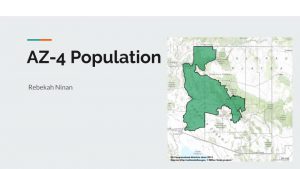
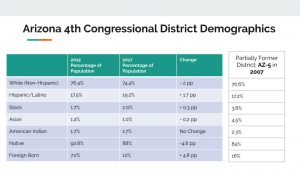
Slide 1:
This slide summarizes the demographic shifts in Arizona’s 4th Congressional District in the time span of five years. The district was created in 2010, using parts of the former 1st, 2nd, and 5th districts of Arizona. The current AZ-4 is considered to be the most Republican congressional district in all of Arizona. The district is predominantly white, with a higher white population and lower Latino population than Arizona as a whole. However, between 2012 and 2017 there was a two percentage point decrease in the white population, a 1.7 percentage point increase in the Hispanic population, and 4.8 percentage point increase in the foreign born population. I interpret this as a moderate increase in both the Hispanic and foreign-born population in the district. I also include data from 2007 in Arizona’s 5th congressional district at the time as it partially comprised what is now AZ-4. We can see that the Hispanic population has increased relative to what it was in AZ-5 in 2007. However, this is not an entirely accurate comparison as the two districts comprise different areas and AZ-4 is significantly more rural.
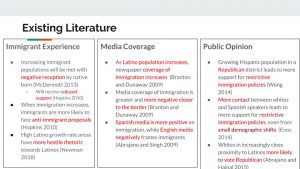
Slide 2:
This slide summarizes the existing literature on how demographic changes affect the immigrant experience, media coverage of immigration issues, and public opinion. The literature I have presented in this slide implies that a growing immigrant, especially Hispanic immigrant, population can spur a “white backlash” and increased media attention. This is particularly true when there are sudden increases in the Hispanic or immigrant population, even if the shifts in the population are small. There is evidence that immigrants will experience negative reception, hostile rhetoric, and increased anti-immigrant policies when the population shifts (McDermott 2013, Hopkins 2010, Newman 2018). As the Latino population increases, newspaper coverage of immigration increases (Branton and Dunaway 2009). This happens particularly when the Latino population makes up between 18% to 30% of the overall population. Unlike Spanish media, English newspapers and other media coverage tends to negatively frame stories about immigration often sensationalizing or using narratives about a Latino threat (Abrajano and Singh 2009). This becomes particularly more evident and happens at a greater rate as one gets closer to the border (Branton and Dunaway 2009). Finally, an increasing Hispanic or immigrant population can impact public opinion of the majority population. Wong (2014) finds that a growing Hispanic population leads to support for more restrictive immigration policies in Republican districts, though it leads to support for more permissive immigration policy in general. Even small demographic changes can lead to whites in proximity of growing Latino populations to become more supportive of restrictive immigration policy and more likely to vote Republican (Enos 2014; Abrajano and Hajnal 2015).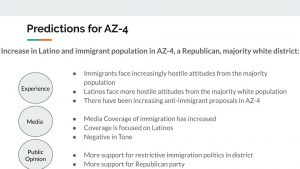
Slide 3:
This slide summarizes the predictions of what we would expect to happen in Arizona’s fourth congressional district based on the presented research. The Hispanic and foreign born populations have both increased in the district. This is predicted to lead to increased negative rhetoric, hostile attitudes and strict policies that would impact the lives of immigrants in the district. Though the Latino population has increased, it still does not exceed 30% of the overall population, so we would expect to see an increase in newspaper coverage of immigration. Given that the minorities are primarily Latino and this is in a border state, we would expect to see the newspaper stories about immigration to be primarily negative, even more-so than national media coverage. This would be particularly true for English media sources compared to their Spanish counterparts. Finally, the area is highly Republican, so we would anticipate the growing foreign born population to actually increase support for restrictive immigration policy. Furthermore, white people in the district could be possibly become more in favor of restrictive policies and even more likely to vote Republican due to the increases in the Latino population.
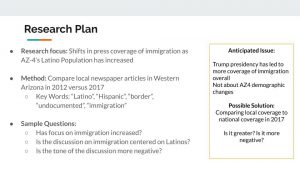
Slide 4:
My research plan is to test the impact that the increasing immigrant and Hispanic population has had on media coverage. I want to see if in the timespan when the demographics were change if the media coverage of immigration has in fact increased and become more negative. I am focusing on the local newpapers in the district. Particularly, I would pull articles from January 2012 and compare them to articles written in January 2018. I would see if the newspapers wrote more about immigration issues in 2018 than in 2012, if the coverage is more negative, and if the focus of the articles draws attention to the immigrants being Latino. While this research method has its strengths, a possible drawback is that immigration politics might just be more salient everywhere in 2018 than they were in 2012. A possible way to combat this is to see if local newspapers in the district focus more on immigration issues than national media overall.